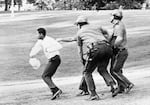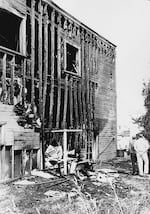The 1960s were a tumultuous time in American history: Civil unrest in many cities across the country led to protests and riots. In 1967 alone, there were over 150 of what officials back then called “race riots” across the country, including in Portland.
On July 30th, 1967, a protest in Portland’s Irving Park over the police treatment of Black people turned into a week of social unrest and clashes with police.
Portland State University professor and historian Darrell Millner spoke with OPB’s Paul Marshall on the anniversary of that event. You can listen to their conversation using the audio player above, and here are highlights:

A man is chased by three Portland policemen during the 1967 Irving Park riot in Albina, an event that had begun as a peaceful rally by black activists.
Oregon Historical Society/Courtesy of the Oregonian
Paul Marshall: On July 30, 1967, about 100 Portlanders gathered in Irving Park. What was the reason for that?
Darrell Millner: The organizers of the Congress on Racial Equality (CORE) had called a meeting to discuss and to protest the kind of interactions that were occurring between young men in the Black community and the police community. The protests eventually turned into a riot, and there was a lot of violence after that.
Marshall: What led to the shift towards that violence?
Millner: You have to appreciate the 1960s. As far as the racial and social issues of the era are concerned, it was tumultuous. It was a period in which young people were especially fed up with the racial status quo. They were not really satisfied with either the approach taken by the white leaders in the city and the nation or the traditional Black leaders from organizations like the Urban League and the NAACP. It was definitely a period in which young Black voices were beginning to challenge older voices both Black and white. They demanded a more assertive, aggressive approach to some of the traditional problems that have plagued the Black community. it was really an expression of young Black dissatisfaction with the status quo
Marshall: How did the city of Portland respond to the riot?
Millner: The city responded in the typical way that mainstream America was responding to many of the pressing social and racial issues of the day. They denied that there was a problem.
If there was activism around a particular issue or problem within their jurisdiction, they would generally blame that reaction on outside agitators, or perhaps communist agitators.
The tendency was to pretend that the racial status quo was certainly an acceptable one. Those parts of it that weren’t acceptable were being addressed and gradually being changed. But the gradual nature of that professed change was never satisfactory to that younger population. The end of the 1960s had become much more aggressive and much more anti-status quo in terms of the things that they were willing to participate in and the kind of strategies that they were willing to follow.
Marshall: How many days did the riot actually last for?
Millner: It’s really difficult to put boundaries on what we might call “a riot.” The emotions and the activities that are going to create an incident like that are not things that just disappear at the end of a particular series of days or particular period of time. They’re going to hold over and they’re going to be a part of the next few weeks, the next few months of reaction, especially in a place like Portland Oregon. Riots don’t happen spontaneously, and they don’t disappear overnight. It’s a part of an ongoing process, and that was certainly true of the Portland situation in 1967.
Marshall: What was the aftermath?
Millner: The problem was not solved, of course. The approach of the traditional leaders, both Black and white that were in place was to try to deny that there were legitimate concerns. They believed that the playing field had dramatically changed.
Their approach was simply to try to deny and avoid accepting that reality. Those problems didn’t go away. There was another riot that occurred, basically in the same place for the same reasons in 1969. It was resistance on the part of the traditional leaders and status quo.
Their preference was to ignore that issue and blame it on outsiders. By blaming it on organizations and groups like the communists, they could try and divert attention away from the real problems that young Black people in the city were facing at the time. The problems didn’t go away.

A building that burned during the 1967 protests that historians call the Albina riot.
Catalog Number OrHi 25045 / Oregon Historical Society
Marshall: As a historian, how is the Albina Riot viewed in the context of Portland civil rights and its struggles? Where does it fall in place with everything?
Millner: Truthfully, I think it has been forgotten. It happened 50 or so years ago. Many of the people who are active in Portland racial matters today weren’t alive at the time or were very young at the time. I don’t really think they connect to that particular part of Oregon and Portland’s racial history. I don’t think they know much about it, and I don’t think it has become kind of a focal point for their vision of what was or what needs to be done about racial matters. I think the real problem that has kind of disconnected us from that time period are the changes that have occurred in the Northeast Portland area.
In Northeast Portland today, if you go to Martin Luther King Boulevard ... It’s nothing like the community that existed there in the 1960s and in the early 1970s. We really don’t have a Black community in Portland anymore, physically speaking. We do have Black people who live here, but we don’t have a Black community.
Marshall: There are parallels between how the city responded to the Albina riot, and Iast year, the months of protests and demonstrations.
Millner: I think you’re accurate when you say that, but there would be one difference that I would suggest to you: Many of the people that were involved in the activities of protests last summer in Portland were white people. There was an element of surprise and amazement that many of the whites in Portland begin to kind experience when they saw what the police would actually do in a situation like that.
That’s a major difference between the riots of the 1960s and the 1970s. The Black people knew what the situation was, what it was going to be and what to expect. The protesters of 2020, were surprised by what they received when they engaged in what they considered to be legitimate protest.
